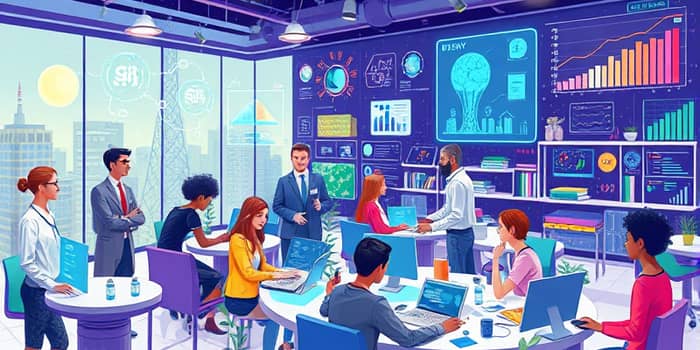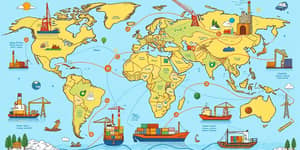In 2025, the workplace is a dynamic ecosystem where technology, demographics, and global trends converge.
As organizations and individuals navigate this transformation, understanding emerging patterns and actionable strategies is crucial for thriving in a shifting labor market.
Executive Summary
The next decade will witness a profound structural transformation of global labor driven by AI, automation, and evolving work models.
Net global job growth is forecast at 78 million new roles by 2030, even as 92 million jobs are displaced.
This article unpacks critical insights on technology, skills, remote work, inclusion, and economic implications, providing practical guidance for employers, policymakers, and workers.
The Technological Revolution and Job Transformation
By 2030, approximately 22% of existing jobs will undergo significant changes, not merely through elimination but via redefinition of responsibilities.
Advances in AI and automation are embedded in daily workflows, augmenting tasks with smart assistants and predictive analytics.
Contrary to common fears, leading organizations and the World Economic Forum project a net gain of 78 million jobs, heralding a renaissance of digital and green roles.
Key areas of opportunity include:
- AI and machine learning specialists
- Data analysts and scientists
- Fintech engineers and software developers
- Renewable energy and sustainability experts
Skills, Hiring, and Labor Market Gaps
The rise of the skills over degrees paradigm marks a shift toward T-shaped professionals—with deep expertise in one area and broad competencies across others.
Employers increasingly favor skill- and aptitude-based hiring, leveraging AI-driven assessments to match candidates to roles beyond traditional credentials.
High-demand soft and technical skills include:
- Adaptability and resilience in fluid environments
- Digital fluency, coding, and data literacy
- Critical thinking and problem-solving
- Emotional intelligence and collaboration
Persistent labor shortages—7.7 million open positions in the US versus 7.1 million job seekers—are most acute in healthcare, construction, and skilled trades, creating upward wage pressures and reskilling incentives.
The Next Normal: Remote, Hybrid, and Flexible Work
Remote work adoption has stabilized, with 22.8% of US employees (36 million people) and 28% globally working remotely at least part-time in March 2025.
Hybrid models are now the gold standard: 83% of workers prefer splitting time between home and office, even though only 16% of companies operate fully remote.
Extensive studies reveal a 13% productivity boost for remote teams and a 50% reduction in employee turnover, underscoring the value of flexibility.
Yet disparities endure: 42.8% of employees with advanced degrees work remotely, compared to just 9.1% of high school graduates, highlighting an inequity in access to remote opportunities.
Workforce Inclusion, Demographic Shifts, and Diversity
Decentralized work arrangements are broadening participation. The US saw an additional 2 million workers with disabilities join the labor force, thanks to remote accommodations.
Diversity gains extend to technical and managerial roles, where geographic barriers have diminished, enabling companies to tap talent from underrepresented regions.
Freelance and portfolio careers—where professionals juggle multiple roles—are on the rise, driven by digital platforms and changing attitudes toward traditional employment.
The Economic and Market Impact
Global labor market churn will affect 22% of jobs through structural shifts by 2030, reshaping demand across sectors.
Frontline roles such as delivery services and health aides continue to expand alongside emerging tech and green jobs, balancing out automation-driven displacement.
Inflationary headwinds and uneven growth may moderate job creation in certain regions, yet the net outlook remains positive.
Strategic Implications for Employers and Policymakers
Organizations are investing heavily in personalized learning paths and upskilling, leveraging AI-powered platforms to close skill gaps rapidly.
Recruitment processes now incorporate automated talent matching, reducing bias and improving candidate experience, though challenges remain with fake postings and ghosting.
Policy frameworks must evolve to support wage insurance, upskilling subsidies, and portable benefits that match the fluid nature of modern careers.
- Implement targeted reskilling grants for displaced workers
- Offer flexible benefit packages for remote and hybrid teams
- Incentivize green job training through tax credits
Future Outlook: Challenges and Opportunities
As AI and human-centric work converge, the future hinges on balancing technological efficiency with empathy and creativity.
Organizations that foster inclusive cultures, embrace continuous learning, and adopt agile structures will unlock unprecedented innovation.
For individuals, cultivating a growth mindset, building cross-disciplinary networks, and staying attuned to market signals will be paramount for long-term success.
Ultimately, the coming decade presents both profound challenges and boundless opportunities for those prepared to adapt, collaborate, and lead in the ever-evolving world of work.
References
- https://standtogether.org/stories/future-of-work/what-will-the-job-market-look-like-key-trends-and-insights
- https://us.neat.no/resources/the-state-of-remote-work-2025-statistics/
- https://blog.theinterviewguys.com/what-experts-are-actually-predicting-for-the-2025-job-market/
- https://www.splashtop.com/blog/remote-work-trends-2025
- https://www.weforum.org/publications/the-future-of-jobs-report-2025/digest/
- https://backlinko.com/remote-work-stats
- https://www.weforum.org/publications/the-future-of-jobs-report-2025/
- https://www.oysterhr.com/library/status-of-remote-work-in-2025










